Shockingly, the average adult aged 35 to 49 in the United States is missing seven teeth. While it’s possible that up to four of these teeth are wisdom teeth, this still means that they are living without at least three of their natural teeth. Therefore, it’s highly likely that you or someone you know have lost teeth or are facing tooth loss in the near future and need to decide how to replace them.
In This Guide
- 1) Dental Implant
- 2) All-on-Four Implant Supported Dentures
- 3) Implant-Supported Fixed Bridge
- 4) Tooth-Supported Fixed Bridge
- 5) Removable Partial Denture
- 6) Removable Complete Dentures
- 7) Resin-Bonded Bridge
- 8) Flipper – a Temporary Replacement Option
- Do Nothing
The best possible option for your oral health and your general health would be to replace each tooth with a dental implant, as implants are the closest thing to restoring a natural tooth. However, this option isn’t always realistic as single implants can be quite expensive, putting them out of reach for many people.
If you are concerned you may not be able to afford all of the implants you need right way (here’s how to find low cost dental implants), this doesn’t mean you cannot revisit this option at a later date when your financial situation has improved. While it’s certainly possible to wait and get implant treatment at a later date, there are other, more affordable solutions for replacing missing teeth.
Here are the 8 tooth replacement options for missing teeth:
1) Dental Implant
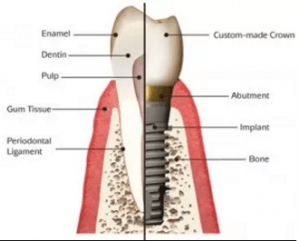
Dental implants have been designed to artificially replace a natural tooth root and are inserted into the jawbone to support a restorative or replacement crown, bridge or denture. They can be the best solution for people missing one or more teeth due to injury, periodontal disease or other oral health problem.
Benefits
- Success rates of treatment are in excess of 95%
- They are durable and permanent
- Minimal maintenance is required other than good oral hygiene and professional dental checkups and cleanings
- Feel natural and comfortable and provide the best aesthetics
- Only tooth loss solution that prevents jawbone loss
- Teeth adjacent to the gap do not need to be modified
- Can be more cost effective in the longer term, due to the long lifespan of treatment
Disadvantages
- Treatment is more invasive – a surgical procedure is required to insert implant
- Treatment takes longer and requires a greater number of dental visits compared to other options
- Most expensive tooth replacement solution
When to Choose Dental Implants
This is the best option if you are suitable for treatment and can afford dental implants. Treatment is a long-term solution for tooth loss and it provides the best aesthetic results.
Although treatment is more expensive, it can be more cost effective in the longer term as implant restorations will not need to be replaced as often as a dental bridge. Additionally, an implant preserves the jawbone and the gum tissue, and there is no need for your dentist to grind down healthy teeth.
2) All-on-Four Implant Supported Dentures

It’s possible to support a full-arch lower denture with just four implants, while an upper denture may require six implants for support. With this treatment, two implants are inserted right at the front of the arch in the positions previously occupied by your front teeth.
The remaining two implants are placed either side and at a 45° angle tilting towards the back of the mouth. The overdenture will clip onto the dental implants using special attachments on its fitting surface.
Benefits
- Affordable due to the fewer number of implants required to support a complete arch of teeth
- More stable and strong than dentures
- Make it possible to enjoy a wider variety of foods compared to dentures
- Can be constructed without a palate so it will feel less bulky and eating will be more enjoyable because you will be able to taste food more easily
- Can easily be removed for cleaning
Disadvantages
- Denture is still removable, which some people may find undesirable
- DCare needs to be taken when eating, as foods that are particularly chewy or hard could damage the denture
- DSpecial attachments on the fitting surface will need to be regularly maintained and must be replaced periodically
When to Choose an Overdenture/All-on-Four Implants
This treatment is relatively affordable and even though the denture is removable, it allows patients to enjoy the stability of having fixed teeth. Treatment may also be suitable for people who have suffered significant jawbone loss. This is because the implants are inserted towards the front of the jaw where the bone tends to be naturally thicker and stronger and more able to support dental implants.
It’s often possible to load the implants quite soon after treatment and patients may be able to receive their new implant supported denture just hours or a day or two after surgery.
3) Implant-Supported Fixed Bridge
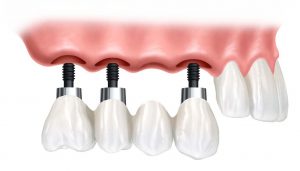
With an implant-supported fixed bridge, it is not necessary to replace every single tooth with a single dental implant. Instead, the implant-supported fixed bridge will restore several missing teeth and it’s possible for this option to replace a complete arch of teeth. The number of implants required can vary according to the type of dental implant used by your implant dentist, and the number of teeth being restored.
An implant-supported bridge looks very similar to a tooth-supported fixed bridge and can either be cemented or screwed into place. Sometimes an implant dentist will choose to screw the bridge onto the implants as this makes it easier to retrieve the bridge should it need cleaning or repairing. The screw holes in the bridge are covered up with tooth-colored composite resin so they are virtually invisible.
Benefits
- Provides very good aesthetic results
- Feels and looks very natural, making it easy to speak and to eat virtually anything
- Easy to look after and can be brushed and flossed just like an ordinary tooth-supported fixed bridge
- Cost is lower compared to replacing every single tooth with a single dental implant
- Should last for many years before it needs replacing
- No need for your dentist to grind down healthy teeth
Disadvantages
- Only suitable if the missing teeth are situated adjacent to each other
- Relatively expensive, particularly when used to restore a complete arch of teeth
- Requires a greater number of visits and treatment takes longer to complete compared to a tooth-supported fixed bridge or a denture
- Implant treatment does require a small surgical procedure
When to Choose an Implant-Supported Fixed Bridge
This option can be ideal for anybody who wishes to enjoy the sensation of having strong and stable teeth that are not removable. Although more expensive than All-on-Four implant-supported dentures, this solution does make it easy to forget you ever lost your teeth. The teeth are strong enough to allow you to eat just about any foods you like, within reason. It also provides excellent aesthetics, especially as the bridge can be constructed to replace any missing gum tissue using gum colored porcelain.
4) Tooth-Supported Fixed Bridge
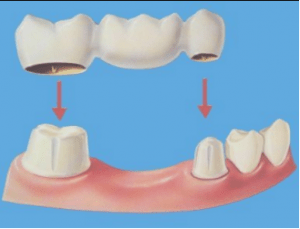
A tooth-supported fixed bridge is the most common alternative to having implant-supported restorations, particularly where a single tooth is missing. A tooth-supported fixed bridge consists of two crowns, normally fitted onto the teeth either side of the gap and these are the abutment teeth. The abutment crowns are attached to the replacement teeth which are called pontics.
This type of restoration is permanently cemented in place. It can be made from a number of different materials that include gold, precious metal alloys, and porcelain, or a tooth-supported fixed bridge may be made from a combination of these materials.
Benefits
- Feel and function just like your real teeth
- Procedure is very straightforward and treatment will normally only take two or three weeks to complete
- Maintenance is easy, as a fixed bridge can simply be brushed and flossed
- Cost effective way to replace missing teeth and is less expensive than implant supported teeth
- Treatment is relatively low risk – if the bridge fails then it can generally be replaced quite quickly and painlessly
Disadvantages
- More expensive than a removable denture
- Teeth adjacent to the gap must be ground down in order to support the bridge, removing healthy tooth structure that can only ever be artificially replaced
- Once these teeth are ground down, there is an increased risk that they could become decayed and infected in the future
- Must thoroughly clean underneath the pontic and there is a possibility that this could become a food trap, especially as bone loss occurs
- Does not provide any stimulation to the bone underneath the bridge
- Does not generally last as long as an implant-supported bridge
When to Choose a Tooth-Supported Fixed Bridge
This option can be best for anyone looking for a quick solution to tooth loss and/or who doesn’t want to undergo surgery. Not everyone wishes to or is suitable for implant surgery, especially if they have medical conditions that have compromised their immune system which can slow down healing, increasing the risk of implant failure.
People in these situations can often obtain better and more predictable results through using a fixed dental bridge. Treatment can often be completed within a matter of just a few weeks rather than the several months required for implant treatment.
5) Removable Partial Denture
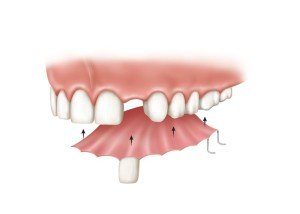
A removable partial denture is designed to replace one or more missing teeth in the same arch and which may or may not be adjacent to each other. The denture consists of an acrylic base which is sometimes strengthened with a Cobalt chrome metal framework.
It will frequently have metal clasps that fit over your existing teeth, holding the denture firmly in place but still allowing it to be easily removed. Some are made from a flexible nylon material and these have clasps made from gum colored nylon so they are less visible in the mouth.
Benefits
- Less expensive than fixed bridges or implants
- Very effective at filling in the gaps in between teeth and restoring your ability to smile
- Restoring missing teeth can help improve your speech and your ability to eat comfortably
- Sometimes possible for additional teeth to be added to the denture
- Procedure is non-invasive and relatively quick
Disadvantages
- Can be unstable and uncomfortable
- May not always look very natural and will not function as well as fixed teeth
- Need to be removed every day and thoroughly cleaned and left out overnight to allow the gums a chance to recover
- Need to be replaced or relined quite frequently
- Quite fragile and easily broken, with the exception of nylon dentures which are unbreakable
- Easy to lose or mislay a partial denture
When to Choose Removable Partial Dentures
Removable partial dentures can be a good option for people who cannot afford dental implants, or who do not have natural teeth that are strong enough to support a fixed bridge.
6) Removable Complete Dentures
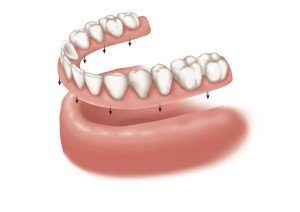
Removable complete dentures rest on top of the gums and are a low-cost and non-invasive alternative to dental implant treatment. Dentures consist of an acrylic gum-colored base to which denture teeth are attached.
Benefits
- Can significantly improve appearance and may help to increase self-confidence by replacing teeth that may have been worn down or decayed
- Provide the correct support for the muscles in the cheeks and lips, restoring facial dimensions and creating a more youthful appearance
- Can help improve speech and the ability to eat comfortably
- Affordable and treatment is relatively fast
- Look quite natural as they come in many different shapes, colors and sizes, while gum tissue can be closely matched to your natural gums
- Can be relined or adjusted to accommodate the changing shape of the jawbone
Disadvantages
- Can become ill-fitting within a very short while as the jawbone changes shape
- Not possible to eat certain foods that are very hard or very sticky without risking damage to the denture
- Have to be removed for cleaning and must be left out overnight to give the gums a chance to recover
- Can accelerate bone loss in the jaw due to the pressure of the denture resting on the gums and the jawbone
- May affect your ability to properly taste food, and they may move around when you eat or speak
- Can rub on gums, creating painful sore spots
- Denture adhesives are often messy and do not offer a long-term solution
- May make a clicking sound when you speak, which can be embarrassing in social situations
When to Choose Removable Complete Dentures
They can be a good low-cost solution for replacing a complete arch of teeth. They are also good for anybody who doesn’t wish to undergo dental implant surgery, or who is not a suitable candidate for treatment.
7) Resin-Bonded Bridge
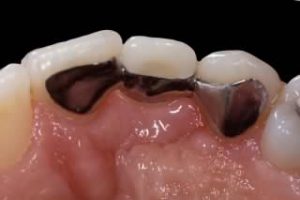
A resin-bonded bridge is sometimes called a Maryland bridge or a Rochette bridge and tends to only be used to replace front teeth. This is because it is relatively fragile and is unable to withstand the chewing forces created by back teeth. It consists of two wings that are attached to the abutment teeth on the tooth surfaces nearest to the tongue, and the wings are attached to the replacement tooth or pontic.
The abutment teeth must be healthy and strong, but it’s unlikely that your dentist will need to change their overall shape very much. Sometimes they may choose to remove a small amount of tooth enamel, as a slightly rougher surface will help increase the bond between the tooth and the bridge.
A Rochette bridge has holes drilled into the wings to help increase this retention. It is a better solution than a removable denture, but it isn’t as strong or as permanent as a fixed bridge and it will not function as well as implants.
Benefits
- Cheaper and less invasive than a fixed bridge supported by your natural teeth
- Restores your ability to smile and to eat and speak
- Provides the correct amount of support for your lips
- Prevents your remaining teeth from drifting out of place
Disadvantages
- Isn’t very strong, which is why it is only used to restore front teeth
- Hard food can cause the bridge to pop off your teeth and need to be re-cemented
- Relatively fragile which doesn’t make it a good long-term option
When to Choose a Resin-Bonded Bridge
This option is cost-effective and non-invasive, particularly when compared to dental implants. It could be a good short-term solution and this type of bridge may occasionally be supplied as a temporary restoration, while an implant heals underneath the gums.
8) Flipper – a Temporary Replacement Option
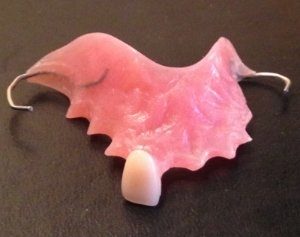
A flipper tooth is a temporary partial denture that is used to restore one or more missing teeth. Its purpose is to fill in any unsightly gaps so that you can smile and talk without feeling self-conscious. A flipper tooth is only used until a more permanent replacement can be fitted.
Benefits
- Treatment is very inexpensive
- Fabricated prior to tooth extraction and fitted right after a natural tooth is removed
- Process requires fewer trips to your dentist compared to a more permanent partial denture
- Lightweight – making them easier to wear and to tolerate
Disadvantages
- Not very strong or stable
- Fragile and easily broken
- Can be bulky, making them uncomfortable to wear, particularly towards the end of a long day
When to Choose a Flipper Tooth
This type of restoration is purely for temporary use, so it can be useful while you decide how to more permanently restore a missing tooth, or while waiting for dental implant treatment to be completed.
Do Nothing
Those were the most popular ways to replace one or more missing teeth, but there is another option – doing nothing. However, this is not an advisable choice if you can help it.
Jawbone density decreases after a natural tooth is removed due to the lack of stimulation that would normally be provided by a natural tooth root. If you later decide to replace the tooth with an implant, you’re more likely to need a bone graft to make up for the lost bone.
Doing nothing will also allow any adjacent teeth to move out of position, potentially destabilizing them and affecting your bite. While it’s not always possible to replace missing teeth immediately after their loss (financially and/or physically), it is important to figure out a more permanent way of replacing them as soon as possible.
What to Read Next
- Dental Bridges vs Implants: Comparison of Costs & Benefits
- Dental Bridges: Types & Procedures
- Dentures vs Dental Implants – Costs & Benefits
- Dental Implant Surgery, Recovery and Aftercare Guide
- Dentures: Partial, Full, Permanent & Immediate
- All on 4 Implants
- Mini Dental Implants Guide
- Dental Flipper Teeth: Cost & Benefits
- How to Find a Dentist You Can Trust
Over to You
We’re interested to know – what tooth replacement option are you leaning towards and why? Let other readers know by leaving a comment below!